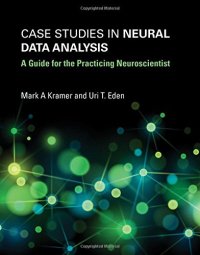
Ebook: Case Studies in Neural Data Analysis: A Guide for the Practicing Neuroscientist
Author: Mark A. Kramer Uri T. Eden
- Tags: Biology, Cell Biology, Developmental Biology, Entomology, Marine Biology, Microbiology, Molecular Biology, Biostatistics, Biological Sciences, Science & Math, Neuroscience, Neurology, Internal Medicine, Medicine, Neuroscience, Basic Sciences, Medicine, Medicine & Health Sciences, New Used & Rental Textbooks, Specialty Boutique, Neurology, Clinical, Medicine, Medicine & Health Sciences, New Used & Rental Textbooks, Specialty Boutique, Science & Mathematics, Agriculture, Astronomy & Astrophysics, Biology & Life Sciences, Che
- Series: Computational Neuroscience Series
- Year: 2016
- Publisher: The MIT Press
- Language: English
- pdf
A practical guide to neural data analysis techniques that presents sample datasets and hands-on methods for analyzing the data.
As neural data becomes increasingly complex, neuroscientists now require skills in computer programming, statistics, and data analysis. This book teaches practical neural data analysis techniques by presenting example datasets and developing techniques and tools for analyzing them. Each chapter begins with a specific example of neural data, which motivates mathematical and statistical analysis methods that are then applied to the data. This practical, hands-on approach is unique among data analysis textbooks and guides, and equips the reader with the tools necessary for real-world neural data analysis.
The book begins with an introduction to MATLAB, the most common programming platform in neuroscience, which is used in the book. (Readers familiar with MATLAB can skip this chapter and might decide to focus on data type or method type.) The book goes on to cover neural field data and spike train data, spectral analysis, generalized linear models, coherence, and cross-frequency coupling. Each chapter offers a stand-alone case study that can be used separately as part of a targeted investigation. The book includes some mathematical discussion but does not focus on mathematical or statistical theory, emphasizing the practical instead. References are included for readers who want to explore the theoretical more deeply. The data and accompanying MATLAB code are freely available on the authors' website. The book can be used for upper-level undergraduate or graduate courses or as a professional reference.